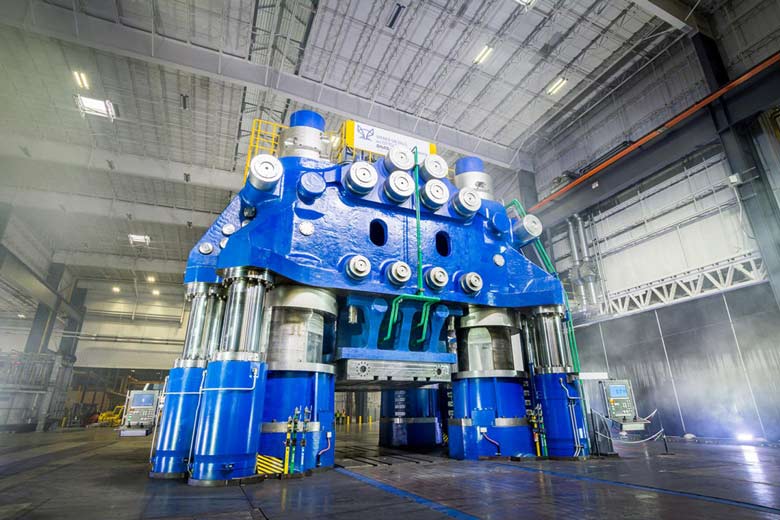The biggest hydraulic presses in the world
The history of the largest forge presses in the world is closely related to the events of World War II and the Cold War era.
Translation and arrangement: Dr. Mehdi Shakuri

Hail to magnesium!
After Germany’s defeat in World War I, this country was forced to sign the Treaty of Versailles in 1920. According to one of the clauses of this treaty, this country was denied access to 55% of its iron ore resources. In the 1930s and 1940s, Nazi Germany’s steel reserves were rapidly depleting, and access to new sources was not possible. On the other hand, this country had rich reserves of magnesium. A light and strong metal that was a suitable option for the construction of new jet planes. However, a technological challenge faced the German engineers.
Due to its high malleability, steel was easily forged, but magnesium could not be forged at all. Magnesium cracks and breaks under hammer blows. To overcome this problem, the scientists of the Third Reich developed a new forming process that was especially useful for large parts: Forming process with controlled speed.

Cold War, Hot Metal
After the Second World War, the arms race between America and Russia, known as the Cold War, began and polarized the world for about half a century. The period when air weapons played a key role. Metallurgical research has led to the invention of new technologies and materials that have made military aircraft lighter and faster.
With the advent of jet planes and increased stresses on them, the demand for more efficient alloys and processes increased. Therefore, titanium, magnesium, and aluminum alloys replaced steel, and their special machining processes were also developed. Forging process, as we have seen, is not suitable for shaping these materials. Because in order to ensure the proper orientation of the threads of these metals and the formation of crack buds, closed molds are needed for forging these metals. Closed die forging with high strength requires powerful and large machines that have not been seen before.
To dominate the world, one must dominate the heavens, and to dominate the heavens, one must first dominate the metals.

legacy of war
While in America, Boeing B-17 Stratofortress and B-29 bombers were assembled by riveting separate metal parts, in Germany light and strong magnesium and aluminum parts were made integrally. Third Reich engineers built a 33,000 ton hydraulic press and two smaller 16,500 ton presses to produce these parts and thus succeeded in producing the first Messerschmitt Me262 fighter jet.
With Germany’s defeat in World War II, the two smaller presses were captured by the United States and the larger press by the Soviet Union. Fearing that this huge press would increase the Soviet military power, America started its heavy press program with the aim of building the largest forge press in the world.
Heavy press program
During this program, 6 extrusion presses and 4 punch presses were built between 1950 and 1957. Two of these 50,000-ton presses are still in operation.

The aluminum giant of the world
One of these presses was made by Mesta Machinery Company. Its weight is 8000 tons and its height is 27 meters. The working table dimensions of this press are 3700 x 7900 mm and its stroke is 1800 mm. Since 1955, this press was managed by the world’s aluminum giant, Alcoa, which bought it from the American government in 1982.
In 2009, the operation of this press was stopped to repair the cracks in its main foundations. The renovation of this press cost about 100 million dollars and its operation was guaranteed for at least the next 50 years.

The second press was built by the Loewe Hydro-press Company and operated since October 1955 by the Gordon-Wyman Company (Air Force Equipment No. 63) in Grafton, Massachusetts. In its hydraulic circuit, oil-water emulsion was used at a pressure of 310 bar and a flow rate of 45,000 liters per minute. Both machines have been used to produce parts for the Boeing 747, the stealth bomber, and the F-35 fighter.

Titanium
It took only 2 years for America to have the largest press in the world. In 1975, the Ukrainian company Mashing Steroidal Avoid (NAKOMA) Novokuznetsk, which specialized in steel equipment, built two 75,000-ton presses. One of them, which was installed in the city of Samara, now belongs to the Russian branch of Alcoa. The second one was installed in the city of Varnisher Salda and used by VSMPO-AVISMA, the largest producer of titanium and other special alloys in the world. The working table dimensions of both machines are 3500 x 16000 mm and their height is 35 meters, 22 meters of which are underground.

France was the third country that made a hydraulic press with high tonnage. A 65,000-ton press built by the Ukrainian company NKMZ and installed in the city of Izvir between 1974 and 1976. This press belongs to Interforge company and with a height of 36 meters, it produces parts for Boeing, Airbus and aerospace and transportation industries.

These steel giants had monopolized the competition scene for many decades. In April 2013, Japan also joined the giant press club with a 50,000 ton hydraulic press. After 60 years, America also built a 60,000 ton hydraulic forging press by SMS Group. The press, operated by Weber Metals in California, has been in operation since October 2018.

